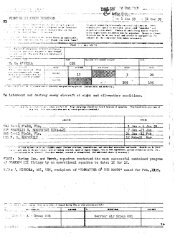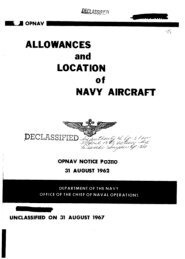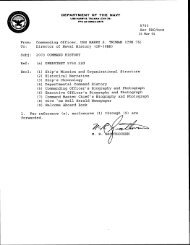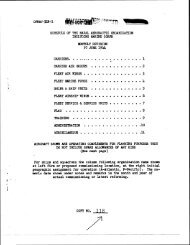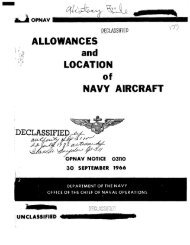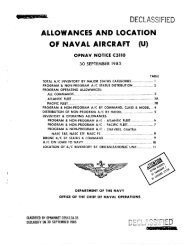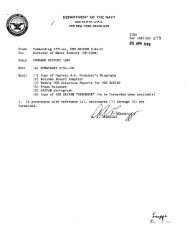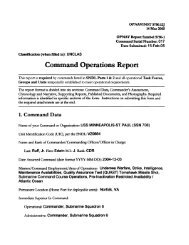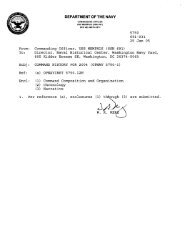Hispanic - Naval History and Heritage Command - U.S. Navy
Hispanic - Naval History and Heritage Command - U.S. Navy
Hispanic - Naval History and Heritage Command - U.S. Navy
You also want an ePaper? Increase the reach of your titles
YUMPU automatically turns print PDFs into web optimized ePapers that Google loves.
hispanics in the<br />
united states navy<br />
The opportunities afforded by the U.S. <strong>Navy</strong> to the diverse people of our country<br />
are not duplicated anywhere else on the planet. —Rear Admiral Albert Garcia III, 2010<br />
A GLOBAL FORCE FOR GOOD.
<strong>Hispanic</strong> Americans have served in the <strong>Navy</strong> throughout our nation’s<br />
history. They have been seamen, 4-star admirals, boatswain’s mates,<br />
corpsmen, fighter pilots, physicians, nuclear engineers, <strong>and</strong> policymakers.<br />
H<br />
ispanic Americans have stood not on the fringes<br />
of the service, but at its center, as makers of<br />
U.S. naval history. Among the first American naval<br />
heroes of <strong>Hispanic</strong> descent was Jorge Anthony Magin<br />
Farragut, born on Minorca, a Mediterranean isl<strong>and</strong><br />
Opposite page: Seaman Miguel A. Vega waits pierside to assist the guided missile frigate USS Crommelin<br />
(FFG 37) docking at Pearl Harbor, Hawaii, after a cruise in the Pacific Ocean, April 2007.<br />
Left: Aboard USS Carl Vinson (CVN 70), Ship’s Surgeon Lt. Cmdr. Kathryn L. Berndt, right, prepares<br />
for surgery a 12-year-old girl injured in the earthquake that struck Haiti in January 2010. Dr. Berndt<br />
called in Dr. Sanjay Gupta, center, CNN medical correspondent <strong>and</strong> practicing neurosurgeon, to<br />
consult in the unusual case. On the left is <strong>Navy</strong> anesthesiologist Cmdr. Jerry Berman. The aircraft carrier<br />
<strong>and</strong> its air wing personnel provided humanitarian <strong>and</strong> disaster relief to earthquake victims under<br />
Operation Unified Response.<br />
1
Left: Sailing Master Jorge Farragut, c. 1800.<br />
Center: Medal of Honor awarded to Seaman<br />
John Ortega, a U.S. Sailor born in Spain in<br />
1840, for gallantry during the Civil War.<br />
Right: Rear Adm. David Farragut’s ships enter<br />
Mobile Bay, 5 August 1864.<br />
under Spanish rule. He fought in the South Carolina<br />
<strong>Navy</strong> during the Revolutionary War <strong>and</strong> served in the U.S.<br />
<strong>Navy</strong> during the War of 1812. Jorge Farragut’s son, David<br />
Glasgow Farragut, was America’s greatest naval officer of<br />
the 19th century <strong>and</strong> the <strong>Navy</strong>’s first full admiral.<br />
Best known for his daring maneuvers at Mobile Bay<br />
in August 1864, David Farragut was forced to make a<br />
crucial decision. Lashed in the rigging of the flagship<br />
Hartford’s mainmast high above the deck, Farragut had a<br />
bird’s-eye view as his fleet fought past the booming guns<br />
of Fort Morgan at the bay’s entrance. When the skipper<br />
of Brooklyn, the lead ship in the column just ahead of<br />
Hartford, reported a line of torpedoes (as mines were<br />
called then) across the channel, the column of ships<br />
began bunching up under the enemy guns. To maneuver<br />
around the torpedoes would expose the ships to the<br />
cannonade. To go forward would mean entering a<br />
minefield. To retreat was out of the question. “Damn the<br />
2
david G. farragut<br />
Born on 5 July 1801 in eastern Tennessee, David Farragut spent<br />
his early youth living in the American frontier <strong>and</strong> speaking both<br />
English <strong>and</strong> Spanish. He entered the <strong>Navy</strong> in 1810 <strong>and</strong> spent<br />
much of the next half century at sea. During the Civil War he<br />
became a rear admiral when he was appointed to comm<strong>and</strong> a<br />
naval squadron in January 1862. By the end of 1864, he had<br />
captured New Orleans, then the South’s biggest city; participated<br />
in operations to seize control of the Mississippi River; enforced the<br />
blockade in the Gulf of Mexico; <strong>and</strong> won the battle of Mobile Bay,<br />
his most famous victory. To reward him for his achievements,<br />
Congress <strong>and</strong> the President in 1866 made him the country’s first<br />
full admiral—equivalent to a four-star admiral today.<br />
“Damn the torpedoes! Full speed ahead!”<br />
David G. Farragut, America’s first admiral, c. 1864.<br />
3
torpedoes!” Farragut shouted. “Full speed ahead!”<br />
Hartford led the rest of the ships into Mobile Bay, <strong>and</strong><br />
Farragut won a storied victory in American naval history.<br />
The <strong>Navy</strong> recognized his notable service by naming a<br />
modern-day ship after him, the guided missile destroyer<br />
USS Farragut (DDG 99), commissioned in June 2006.<br />
During World War II an estimated quarter-million<br />
to a half-million <strong>Hispanic</strong> Americans served in the U.S.<br />
Armed Forces, making up about 2.5 to 5 percent of the<br />
total force. Many distinguished themselves in the <strong>Navy</strong><br />
during the war. Submariner Marion Frederic Ramirez de<br />
Arellano, a U.S. <strong>Naval</strong> Academy graduate from Puerto<br />
Rico, helped sink enemy ships while serving on three<br />
different submarines. He became the first <strong>Hispanic</strong><br />
submarine skipper when he took comm<strong>and</strong> of USS Balao<br />
(SS 285) on 18 April 1944. For his actions against the<br />
Imperial Japanese <strong>Navy</strong> during World War II, he received<br />
two Silver Stars, the Legion of Merit, <strong>and</strong> the Bronze Star.<br />
<strong>Hispanic</strong> American naval officers <strong>and</strong> enlisted men<br />
<strong>and</strong> women continued to serve with honor in the Korean<br />
<strong>and</strong> Vietnam wars as well as throughout the Cold War<br />
when the <strong>Navy</strong> defended sea lanes against a potential<br />
Soviet threat. During the 1970s the <strong>Navy</strong> developed an<br />
affirmative action plan that for the first time set<br />
Bottom left: Cmdr. (later Capt.) Ramirez de Arellano,<br />
right, receives the Silver Star—the fourth highest U.S.<br />
military decoration. In 1944 he was the first <strong>Hispanic</strong><br />
comm<strong>and</strong>ing officer of a submarine, USS Balao<br />
(SS 285), top. Later in the war he comm<strong>and</strong>ed a<br />
submarine division.<br />
Right: <strong>Navy</strong> ace Eugene A. Valencia Jr. (see sidebar)<br />
flew an F6F Hellcat, like the one shown here, in<br />
World War II.<br />
4
eugene A. valencia jr.<br />
San Francisco native Eugene A. Valencia Jr. shot down 23 enemy<br />
aircraft in the Pacific during World War II, led the most successful<br />
fighter plane division in American naval history, <strong>and</strong> remains the<br />
<strong>Navy</strong>’s third-ranking ace of all time. Appointed Aviation Cadet on<br />
1 August 1941, Valencia got his baptism of fire flying a U.S. <strong>Navy</strong><br />
Hellcat in October 1943 during strikes against Japanese forces on<br />
Wake Isl<strong>and</strong> <strong>and</strong> at Tarawa Atoll. After several dogfights with the<br />
enemy aircraft, he spotted a weakness in their gunnery. Returning<br />
stateside for training, he developed a tactic nicknamed the “mowing<br />
machine” to exploit this weakness. When Fighter Squadron 9<br />
redeployed to the Pacific in 1945, Valencia <strong>and</strong> his four-plane<br />
division tallied 43 of the squadron’s 130 victories. That year he<br />
received the <strong>Navy</strong> Cross for his outst<strong>and</strong>ing service.<br />
“I love [the Hellcat] so much, that if [I could],<br />
I’d marry it.”<br />
Lt. Eugene Valencia Jr., c. 1944.<br />
5
ecruiting goals for people of “Spanish heritage.” In<br />
1979 Edward Hidalgo became the first <strong>Hispanic</strong><br />
Secretary of the <strong>Navy</strong> <strong>and</strong> made recruiting more Latinos<br />
<strong>and</strong> Latinas, especially as officers, a top priority. At first,<br />
the <strong>Navy</strong> set the recruiting goal for <strong>Hispanic</strong> officers at<br />
a figure reflecting the proportion of Latinos <strong>and</strong> Latinas<br />
with college degrees. In July 1994 the Secretary of the<br />
<strong>Navy</strong> launched an initiative seeking to achieve a naval<br />
officer corps that reflected the proportion of <strong>Hispanic</strong><br />
people in the United States. This has been the <strong>Navy</strong>’s<br />
goal ever since. As of June 2010, 6.2 percent of officers<br />
<strong>and</strong> 17.2 percent of enlisted men <strong>and</strong> women in the<br />
<strong>Navy</strong> were of <strong>Hispanic</strong> ethnicity.<br />
Top: U.S. <strong>Naval</strong> Academy graduate Marine 1st Lt.<br />
Baldomero Lopez, shown leading his platoon over<br />
the seawall at Inchon, Korea, in September 1950,<br />
received the Medal of Honor posthumously for his<br />
heroic actions there.<br />
Left: Edward Hidalgo, the first <strong>Hispanic</strong> Secretary<br />
of the <strong>Navy</strong>, served from 1979 to 1981 during the<br />
Carter administration.<br />
Right: Lt. Al Cisneros was the first Latino pilot<br />
to serve with the Blue Angels, the <strong>Navy</strong>’s flight<br />
demonstration squadron.<br />
6
horacio rivero jr.<br />
Horacio Rivero Jr. was known for his keen intellect, leadership, <strong>and</strong><br />
contributions in developing nuclear weapons. Born in Puerto Rico,<br />
Rivero graduated third among the 441 members of the U.S. <strong>Naval</strong><br />
Academy class of 1931. Recognizing his intellect, the <strong>Navy</strong> sent Rivero<br />
to graduate school, first to the <strong>Naval</strong> Postgraduate School <strong>and</strong> then to<br />
the Massachusetts Institute of Technology, where he earned a master<br />
of science degree in electrical engineering. Rivero spent most of<br />
World War II on board cruisers, serving in many of the most significant<br />
battles in the Pacific.<br />
continued on page 8<br />
“[<strong>Naval</strong> War College provided me] the<br />
opportunity to meet <strong>and</strong> make friends with<br />
a lot of people from the Army, the Air Force,<br />
State Department, CIA, Treasury, <strong>and</strong> so<br />
forth. . . . And we had the cream of the <strong>Navy</strong><br />
going into it.”<br />
Adm. Horacio Rivero Jr., Vice Chief of <strong>Naval</strong> Operations <strong>and</strong> the first Latino full admiral of the<br />
20th century, takes a ride on a Swift boat off Cam Ranh Bay, South Vietnam, July 1966.<br />
7
continued from page 7<br />
Witness the success of a h<strong>and</strong>ful of<br />
many firsts for <strong>Hispanic</strong>s.<br />
• The first four Latinas graduated from<br />
the U.S. <strong>Naval</strong> Academy in 1981: Lilia<br />
Ramirez of Bayshore, New York;<br />
Carmel Gillil<strong>and</strong> of Albuquerque, New<br />
Mexico; Trinora Pinto of Louisville,<br />
Kentucky; <strong>and</strong> Ina Gomez of Gr<strong>and</strong><br />
Junction, Colorado.<br />
•Before retiring from the <strong>Navy</strong> in 1996,<br />
Rear Admiral Marc Y. E. Pelaez, Chief<br />
of <strong>Naval</strong> Research, managed the <strong>Navy</strong><br />
<strong>and</strong> Marine Corps’ science <strong>and</strong><br />
technology programs. With an annual<br />
budget of $1.5 billion, his comm<strong>and</strong><br />
As a pioneer in nuclear weapons development after the war,<br />
Rivero became a charter member in the <strong>Navy</strong> Department’s Atomic<br />
Operations Division. This assignment put him on the cutting edge of<br />
the era’s highest technology. In 1946 he participated in Operation<br />
Crossroads, the atomic bomb tests on Bikini Atoll in the Pacific, <strong>and</strong><br />
two years later he participated in similar tests in Eniwetok. In March<br />
1949 he became one of the original members of the Weapons<br />
Systems Evaluation Group, Office of the Secretary of Defense. On 3<br />
October 1955 the <strong>Navy</strong> promoted him to rear admiral <strong>and</strong> assigned<br />
him duty working on hydrogen bombs.<br />
During the 1950s <strong>and</strong> 1960s Rivero began his climb to the <strong>Navy</strong>’s<br />
top echelons, serving in a variety of staff <strong>and</strong> comm<strong>and</strong> positions.<br />
Highlights include a tour with the Atlantic Fleet staff <strong>and</strong> a stint as<br />
Director of <strong>Navy</strong> Program Planning in the Office of the Chief of <strong>Naval</strong><br />
Operations, where he laid the groundwork for the building of the Nimitzclass<br />
aircraft carriers. Promoted to full admiral in 1964, he served<br />
as Vice Chief of <strong>Naval</strong> Operations <strong>and</strong> later became Comm<strong>and</strong>er in<br />
Chief of Allied Forces, Southern Europe. Had the Cold War turned<br />
hot <strong>and</strong> war broken out, Admiral Rivero would have comm<strong>and</strong>ed a<br />
million service men <strong>and</strong> women from five countries. Rivero remained<br />
in comm<strong>and</strong> of NATO’s Southern Forces until his retirement on 1 June<br />
1972 after 41 years of service.<br />
Rear Adm. Marc Y. E. Pelaez, Chief of<br />
<strong>Naval</strong> Research from 1993 to 1996.<br />
8
kathryn berndt<br />
Raised in Texas, Kathryn Berndt graduated from Harvard University<br />
with a degree in psychology. But what she really wanted to do was to<br />
practice medicine. She concluded that a <strong>Navy</strong> scholarship program<br />
would provide the most economical route to her goal. After earning<br />
her M.D. at Tufts University, she was promoted to lieutenant <strong>and</strong><br />
entered active duty service. Dr. Berndt has since served as Medical<br />
Department head on the amphibious ship USS Ogden (LPD 5) <strong>and</strong><br />
completed her general surgery residency at <strong>Naval</strong> Medical Center<br />
San Diego. “The <strong>Navy</strong> has given me the opportunity to excel in ways<br />
in which I had only dreamed about,” she said. “To become a doctor,<br />
to become a surgeon, <strong>and</strong> to have a wonderful family.” Dr. Berndt,<br />
now a lieutenant comm<strong>and</strong>er, serves as the ship’s surgeon on board<br />
the carrier USS Ronald Reagan (CVN 76) <strong>and</strong> was also the surgeon<br />
on USS Carl Vinson (CVN 70) when the ship responded to the<br />
earthquake in Haiti in January 2010.<br />
“The <strong>Navy</strong> has given me the opportunity<br />
to excel in ways in which I had only<br />
dreamed about.”<br />
Dr. Kathryn Berndt on board USS Carl Vinson off the coast of Haiti in January 2010.<br />
9
included the Office of <strong>Naval</strong> Research, the <strong>Naval</strong><br />
Research Laboratory, <strong>and</strong> foreign field offices in London<br />
<strong>and</strong> Tokyo.<br />
•In 1997 Marine Lieutenant Colonel Carlos I. Noriega<br />
logged 221 hours in space during NASA’s sixth space<br />
shuttle mission to dock with the Russian Space<br />
Station Mir.<br />
•In 2001 President George W. Bush appointed William<br />
A. Navas as Assistant Secretary of the <strong>Navy</strong> for<br />
Manpower <strong>and</strong> Reserve Affairs. A native of Puerto Rico<br />
<strong>and</strong> a decorated combat veteran of the Vietnam War,<br />
Navas also held the rank of Major General in the Army<br />
<strong>and</strong> the position of Director of the Army National Guard.<br />
•In 2003 the Puerto Rico Medical Society named<br />
<strong>Navy</strong> surgeon Comm<strong>and</strong>er Miguel A. Cubano<br />
Physician of the Year.<br />
Clockwise from top left: Marine Lt. Col. Carlos I. Noriega, a mission specialist<br />
on Space Shuttle Atlantis mission STS-84, suits up during final prelaunch<br />
preparations at Kennedy Space Center, Fla., 1997; Cmdrs. Miguel A. Cubano<br />
<strong>and</strong> Eliseo E. Bautista, <strong>Navy</strong> surgeons, operate on a patient at <strong>Naval</strong> Hospital<br />
Jacksonville, Fla., September 2003; Capt. Kathlene Contres, with Representative<br />
Grace Napolitano (D-CA), receives a leadership award from Latina<br />
Style magazine, September 2005; Secretary of the <strong>Navy</strong> Gordon R. Engl<strong>and</strong><br />
presents the <strong>Navy</strong> Cross to Hospitalman Apprentice Luis E. Fonseca Jr., who<br />
saved the lives of several wounded Marines during the 2003 battle of<br />
An Nasiriyah, Iraq.<br />
10
Left to right: Master Chief Petty Officer of the <strong>Navy</strong><br />
Joe R. Campa Jr. speaks with Sailors at Bagram<br />
Air Force Base, Afghanistan, 2008; the guided<br />
missile frigate USS Curts (FFG 38) deployed to the<br />
North Arabian Sea in 2008 under comm<strong>and</strong>ing<br />
officer Yvette Davids, the first Latina to comm<strong>and</strong><br />
a warship; Cmdr. Davids, as the military executive<br />
assistant to the executive director of <strong>Naval</strong> Surface<br />
Forces, presents a certificate of commendation<br />
to Cadet Seaman Emmarow Taledo, an honors<br />
freshman in the <strong>Navy</strong> Junior Reserve Officer<br />
Training Corps at Junipero Serra High School in<br />
San Diego, Calif., April 2009.<br />
•As a result of extraordinary heroism while serving with<br />
the Marines during the battle of An Nasiriyah, Iraq, in<br />
March 2003, Hospitalman Apprentice Luis E. Fonseca<br />
Jr. received the <strong>Navy</strong> Cross, the highest medal the<br />
Department of the <strong>Navy</strong> can award <strong>and</strong> the second<br />
highest medal for valor after the Medal of Honor.<br />
•Captain Kathlene Contres was the <strong>Navy</strong>’s highest<br />
ranking female <strong>Hispanic</strong> active duty line officer<br />
when she became Comm<strong>and</strong>ant of the Defense<br />
Equal Opportunity Management Institute in March<br />
2005. Educating more than 1,200 students per<br />
year, the Institute is the Defense Department’s<br />
center of excellence for equal opportunity, equal<br />
employment opportunity, <strong>and</strong> human relations<br />
education, training, <strong>and</strong> research.<br />
•In July 2006 Joe R. Campa Jr. became the first<br />
<strong>Hispanic</strong> Master Chief Petty Officer of the <strong>Navy</strong>,<br />
the service’s top-ranking enlisted person.<br />
•U.S. <strong>Naval</strong> Academy graduate Comm<strong>and</strong>er Yvette<br />
Davids, the first Latina comm<strong>and</strong>ing officer of a<br />
surface combatant ship, assumed comm<strong>and</strong> of the<br />
guided missile frigate USS Curts (FFG 38) in 2007.<br />
11
These few examples represent a fraction of <strong>Hispanic</strong><br />
success stories in America’s <strong>Navy</strong>. <strong>Hispanic</strong> Americans<br />
have served in nearly every position the service has to<br />
offer, whether at sea, under the sea, in the air, on l<strong>and</strong>,<br />
or in space. In the foreseeable future there will be no<br />
more “firsts,” for the day will come when a Latino or<br />
Latina will have served in every <strong>Navy</strong> billet.<br />
In the 21st century the <strong>Navy</strong>’s leadership remains<br />
strongly committed to diversity. Chief of <strong>Naval</strong><br />
Operations Admiral Gary Roughead declared that the<br />
<strong>Navy</strong> “must embrace the demographic changes of<br />
tomorrow, <strong>and</strong> build a <strong>Navy</strong> that always reflects our<br />
country’s makeup.”<br />
A person who is motivated <strong>and</strong> hardworking, <strong>and</strong><br />
has the honor, courage, <strong>and</strong> commitment to serve, can<br />
achieve his or her dreams, regardless of race, creed,<br />
color, or ethnic origin.<br />
Clockwise from top left: Seabee Rosa Medina prepares for a field training exercise at Camp<br />
Hansen in Okinawa, Japan, April 2007; Chief Warrant Officer Arm<strong>and</strong>o Garcia <strong>and</strong> his son,<br />
Corporal Arm<strong>and</strong>o Garcia, on the flight deck of USS Denver (LPD 9) are both deployed with<br />
the Marines in the western Pacific, July 2002; Yeoman 2nd Class Adrianna Mueller helps<br />
prepare Lt.j.g. Leticia Soto for the Seabee Combat Warfare Specialist test, April 2004; Aviation<br />
Maintenance Administrationman 2nd Class Jesus Lopez signals an OK to supervisors<br />
during diving proficiency training, February 2005; Lt. Alej<strong>and</strong>ro Hern<strong>and</strong>ez signals for an<br />
F/A-18C Hornet to launch from the aircraft carrier USS Dwight D. Eisenhower (CVN 69)<br />
steaming in the Red Sea, May 2007; Aviation Electronics Technician Airman William Vasquez<br />
removes an instrument l<strong>and</strong>ing system receiver from an F/A-18F Super Hornet aboard the<br />
aircraft carrier USS Theodore Roosevelt (CVN 71) in the Gulf of Oman, January 2009.<br />
12
Clockwise from top left: Rear Adm. Albert Garcia III, the deputy comm<strong>and</strong>er of<br />
the First <strong>Naval</strong> Construction Division, talks to Ana Mejia of Azteca America TV<br />
during a Cinco de Mayo festival in Denver, Colo., May 2008; U.S. <strong>Navy</strong> Hospitalman<br />
Garret Castro interviews a patient at a field hospital in Shinkiari, Pakistan,<br />
during humanitarian assistance to victims of an earthquake that devastated the<br />
region on 8 October 2005; Seabee Eduardo Riveragonzalez fires a machine gun<br />
down range during weapons qualifications in central Iraq, April 2004; Damage<br />
Controlman 3rd Class Matthew Villafuerte, member of a visit, board, search <strong>and</strong><br />
seizure team, secures a machine gun to its mount on a rigid-hull inflatable boat<br />
being lowered from the guided missile frigate USS Ingraham (FFG 61) into the<br />
Arabian Gulf, February 2008; Comm<strong>and</strong> Master Chief Michael R. Ruiz serves<br />
in Iraq with the 1st Marine Expeditionary Force, December 2008; Aviation<br />
Boatswain’s Mate (H<strong>and</strong>ling) 3rd Class Gerson Gonzalez signals to an MH-60<br />
helicopter during a vertical replenishment aboard the amphibious transport<br />
dock USS Clevel<strong>and</strong> (LPD 7) in the Arabian Gulf, February 2008.<br />
Photo credits: Latina Style, <strong>Naval</strong> <strong>History</strong> & <strong>Heritage</strong> Comm<strong>and</strong>, NAVY.mil.<br />
Front cover: Quartermaster 2nd Class Carolina Castanon makes her rounds<br />
in <strong>Naval</strong> Support Activity Bahrain’s Harbor Patrol Unit, September 2003.<br />
Castanon helped maintain round-the-clock watches protecting the personnel<br />
stationed in Bahrain.<br />
13
<strong>Navy</strong> Diversity Directorate (N134)<br />
Chief of <strong>Naval</strong> Personnel<br />
www.npc.navy.mil/Comm<strong>and</strong>Support/Diversity<br />
www.history.navy.mil<br />
A GLOBAL FORCE FOR GOOD.




